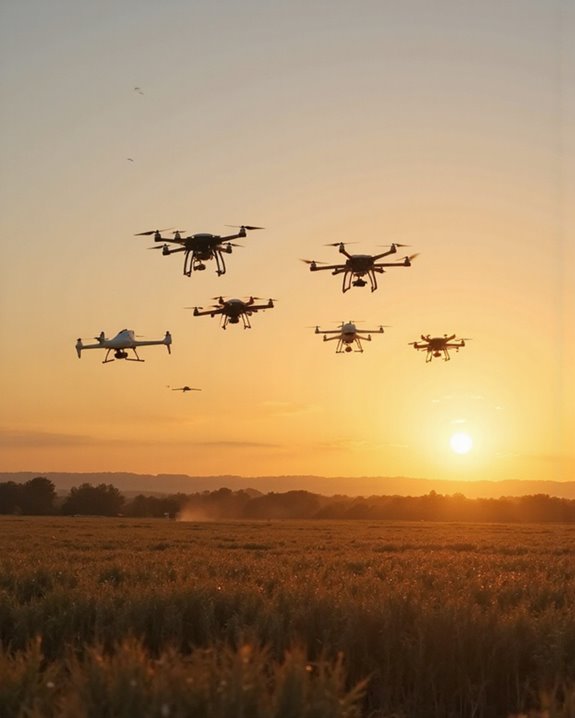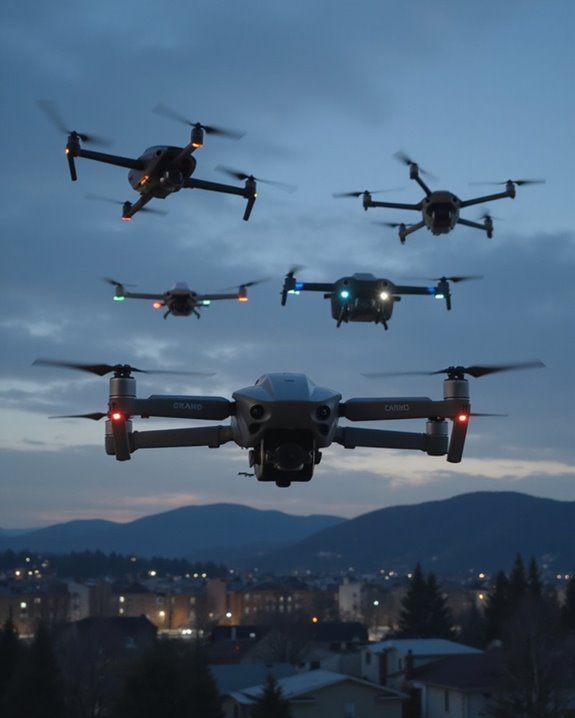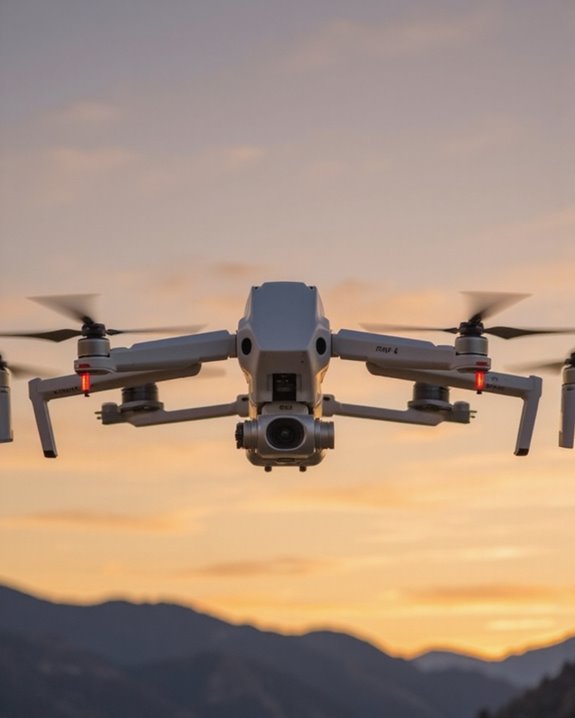Links below are affiliate links. We earn a commission on purchases at no extra cost to you. Although our opinions are based on curated research, we haven't used these products. Articles generated with AI.
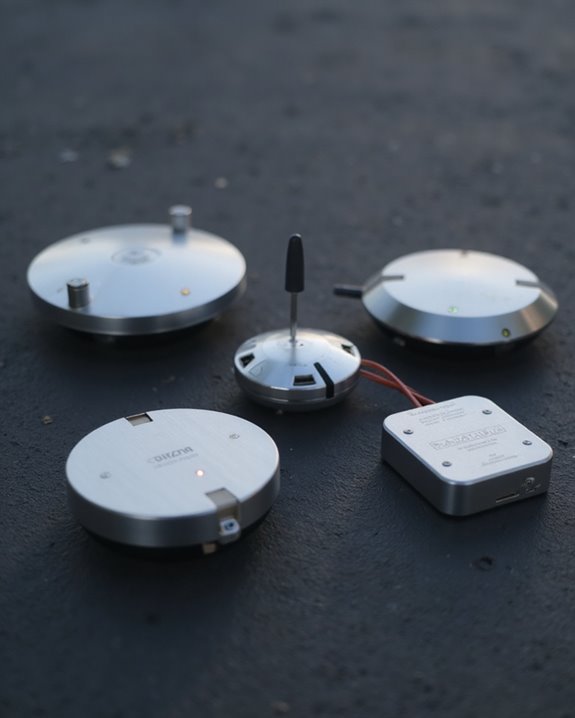
5 Best Drone Remote Id Module
The top Remote ID modules for your drone combine reliability with easy installation! The Veeniix V113 and Bwine B112 lead the pack with impressive 5-hour battery life and precise GPS tracking under 3 meters. Holy Stone’s module offers great value with excellent protection features, while the FAA Compliant 300-minute module delivers extended flight operations. These compact units (around 13.5g) won’t weigh down your drone, and they’re all FAA-compliant. Let’s explore which module best matches your specific flying needs.
Key Takeaways
- Veeniix V113 leads with precise GPS tracking under 3 meters, 5.1-hour battery life, and compatibility across DJI models.
- Bwine B112 offers excellent value with 40-minute fast charging, 5-hour battery life, and 30% smaller design than standard modules.
- Holy Stone module provides reliable performance with overcharging protection and high user satisfaction (4.5 stars from 600+ reviews).
- FAA Compliant Remote ID Module features 300-minute battery life, dust-proof design, and ultra-precise tracking up to 800m range.
- All recommended modules weigh approximately 13.5g and include multiple mounting options for easy installation on various drone models.
FAA Compliant Remote ID Module for Drones
FAA Compliant Remote ID Module for Drone, 300Mins Battery Time, 13.49g Light Weight RID Module for...
- 🔥【𝐅𝐀𝐀 𝐑𝐞𝐠𝐮𝐥𝐚𝐭𝐢𝐨𝐧 𝐂𝐨𝐦𝐩𝐥𝐢𝐚𝐧𝐜𝐞】Veeniix Remote ID Module is suitable for a range of 4K camera...
- 🔥【𝐔𝐥𝐭𝐫𝐚-𝐂𝐨𝐦𝐩𝐚𝐜𝐭 𝐑𝐞𝐦𝐨𝐭𝐞 𝐈𝐃 𝐌𝐨𝐝𝐮𝐥𝐞】Veeniix Remote Identification Broadcast Module...
- 🔥【𝐔𝐥𝐭𝐫𝐚-𝐒𝐮𝐢𝐭𝐚𝐛𝐥𝐞 𝐟𝐨𝐫 𝐯𝐚𝐫𝐢𝐨𝐮𝐬 𝐭𝐲𝐩𝐞𝐬 𝐨𝐟...
For drone pilots seeking hassle-free FAA compliance, the Veeniix V113 Remote ID module stands out as a versatile powerhouse that works with an impressive range of popular models! You’ll love how this lightweight champ weighs just 13.49g while packing serious functionality into its compact 1.5×1.34×0.53-inch frame.
Whether you’re flying a DJI Mini series, Phantom, or even DIY builds, this module’s got you covered with precise GPS tracking under 3 meters and real-time monitoring up to 800m. With 5.1 hours of continuous use and simple Type-C charging, you won’t be caught mid-flight without compliance. Plus, the included Velcro patches and zip ties make installation a breeze – no engineering degree required!
Best For: Drone enthusiasts and professional pilots who need an easy-to-install, reliable Remote ID solution that’s compatible with a wide range of popular drone models including DJI, custom builds, and FPV aircraft.
Pros:
- Exceptional compatibility across numerous drone models and manufacturers
- Long battery life with 5.1 hours of continuous use
- Lightweight design (13.49g) with precise GPS tracking under 3 meters
Cons:
- Premium price point compared to basic Remote ID solutions
- Requires external mounting which may affect drone aesthetics
- Limited to 800m tracking range which may not suit all professional applications
Bwine B112 FAA Remote ID Module for Drones
Bwine B112 FAA Compliant Remote ID Module, GPS Tracking, 5-Hour Long Battery Life, Spare Parts for...
- FAA Compliance: Meet FAA requirements for drones >250g (0.55 lbs) effortlessly. The B112 module replaces bulky external RID systems, ensuring legal flight for Mavic 3,...
- Below 3m GPS Accuracy: Broadcast real-time drone/operator coordinates (latitude, longitude, altitude, speed) with <3m error. Effective range: 500-800m. Ideal for 4K...
- Ultra-Wide Compatibility: Fits FPV drones, RC gliders, helicopters, jet fighters, fixed-wing aircraft, multirotors, paragliders, and niche models. Includes 4 installation...
Serious drone pilots looking for a compact and versatile Remote ID solution will find the Bwine B112 extremely compelling. At just 13.5g and 30% smaller than standard modules, you’ll barely notice it’s there! The module broadcasts your location with impressive <3m accuracy and works with tons of popular models like the Mavic 3, Mini 4 Pro, and even RC gliders.
You’ll love the convenient 5-hour battery life and quick 40-minute charging via Type-C. Installation’s a breeze with four mounting options, and the built-in buzzer helps you locate your drone. The companion app makes setup simple through Bluetooth or Wi-Fi – no rocket science degree required!
Best For: Drone enthusiasts and professional pilots who need to comply with FAA Remote ID requirements while maintaining their aircraft’s performance with a lightweight, versatile solution.
Pros:
- Extremely compact and lightweight (13.5g) with minimal impact on drone performance
- Broad compatibility across many popular drone models and aircraft types
- Long 5-hour battery life with convenient 40-minute fast charging
Cons:
- Limited broadcast range of 500-800m may not be sufficient for long-range operations
- First available August 2024, so relatively new to market with potential early adoption issues
- Requires regular charging maintenance and power management for safe operation
Holy Stone FAA Remote ID Broadcast Module for GPS Drones
Holy Stone FAA Compliant Remote Identification broadcast Module Spare Parts for GPS Drones with...
- FAA Regulation Compliance: Holy Stone is committed to working out a solution to the US FAA Declaration of Compliance for our rc drone consumers; here we got the Remote ID...
- Compatibility: Holy Stone Drones with Camera for Adults 4K, Holy Stone HS720R, HS720G, HS720E, HS720, HS700E, HS600 GPS 4K Drone; moreover, the Remote ID broadcast Module...
- Safety and Performance: Holy Stone Remote ID broadcast Module Parts with Protection for overcharging, over-discharging protection, and low temperatures, allow all our...
Drone pilots searching for an affordable FAA compliance solution will find their answer in the Holy Stone Remote ID Broadcast Module. This compact, lightweight module is compatible with multiple Holy Stone models, including the popular HS720 series and HS700E drones.
You’ll love how easy it is to set up this little lifesaver, which protects against overcharging and temperature issues while broadcasting your drone’s ID as required by law. With a 4.5-star rating from over 600 users, it’s the smallest and most budget-friendly certified module you’ll find! The setup takes just minutes, and you can verify it’s working through any drone scanner app – perfect for meeting that March 2024 compliance deadline without breaking the bank.
Best For: Drone pilots who need an affordable and easy-to-install Remote ID compliance solution for their Holy Stone drones before the March 2024 FAA deadline.
Pros:
- Highly affordable compared to other Remote ID solutions
- Quick and simple setup with easy-to-follow instructions
- Compatible with multiple Holy Stone drone models including the HS720 series
Cons:
- Limited compatibility – primarily works with Holy Stone drones
- Some users may need to purchase through affiliate links for best pricing
- Protection features are basic (overcharging and temperature only)
Drone FAA UAS Registration ID Card for Hobbyist Pilots
Drone FAA UAS Registration ID Card for Hobbyist Pilots
- Customized FAA UAS registration ID Card with your FAA registration information
- Credit card sized FAA ID Card, printed on both sides, duplicates email sent by FAA
- ID card is made of 30 mil PVC for maximum durability
Recreational pilots looking to stay compliant with FAA regulations will appreciate this professionally crafted UAS registration ID card, which perfectly duplicates your official FAA documentation in a durable, wallet-friendly format.
Made of sturdy 30 mil PVC with optional crystal-clear lamination, this credit card-sized companion won’t disintegrate like paper copies in your wallet! You’ll love how it matches the FAA’s email version exactly, and it even comes with handy stickers for your drones. While it’s marked “for reference only,” this American-made card from Drone ID Services has earned rave reviews from pilots who want their registration info readily accessible without fumbling through emails or paperwork.
Best For: Recreational drone pilots who want a durable, wallet-sized copy of their FAA registration information that’s easily accessible during flights.
Pros:
- Highly durable 30 mil PVC construction with optional lamination that won’t deteriorate like paper copies
- Includes drone stickers and perfectly matches official FAA documentation
- Made in USA with excellent customer reviews (4.6/5 stars from 105 ratings)
Cons:
- Not a legal document – for reference purposes only
- Relatively expensive for what is essentially a backup copy of free documentation
- Limited functionality beyond serving as a convenient reference card
FAA Compliant Remote ID Module for Drones (300Min Battery)
FAA Compliant Remote ID Module for Drone, 300Mins Battery Time, 13.49g Light Weight RID Module for...
- 🔥【𝐅𝐀𝐀 𝐑𝐞𝐠𝐮𝐥𝐚𝐭𝐢𝐨𝐧 𝐂𝐨𝐦𝐩𝐥𝐢𝐚𝐧𝐜𝐞】Veeniix Remote ID Module is suitable for a range of 4K camera...
- 🔥【𝐔𝐥𝐭𝐫𝐚-𝐂𝐨𝐦𝐩𝐚𝐜𝐭 𝐑𝐞𝐦𝐨𝐭𝐞 𝐈𝐃 𝐌𝐨𝐝𝐮𝐥𝐞】Veeniix Remote Identification Broadcast Module...
- 🔥【𝐔𝐥𝐭𝐫𝐚-𝐒𝐮𝐢𝐭𝐚𝐛𝐥𝐞 𝐟𝐨𝐫 𝐯𝐚𝐫𝐢𝐨𝐮𝐬 𝐭𝐲𝐩𝐞𝐬 𝐨𝐟...
Professional pilots and aviation enthusiasts who need reliable drone tracking will find exceptional value in this FAA-compliant Remote ID module. At just 13.49g, this compact powerhouse fits seamlessly with popular models like the DJI Mini series, Air series, and even the mighty Matrice drones!
You’ll love the impressive 300-minute battery life and ultra-precise GPS tracking (under 3 meters accuracy). The module’s versatility shines with its Bluetooth connectivity, dust-proof design, and generous mounting options – from Velcro patches to zip ties. Whether you’re flying a sleek DJI Mini or tinkering with DIY builds, this little black box keeps you legal and connected with real-time tracking up to 800m.
Best For: Professional drone pilots, hobbyists, and commercial operators who need an FAA-compliant Remote ID solution that works across a wide range of popular drone models while offering extended battery life and reliable tracking.
Pros:
- Exceptional 300-minute battery life with continuous use up to 5.1 hours
- Broad compatibility with major drone brands and models, including DJI, ATOM, and custom builds
- High-precision GPS tracking (under 3 meters accuracy) with real-time monitoring up to 800m
Cons:
- Premium price point compared to basic Remote ID modules
- Requires physical mounting space on the drone which may affect aerodynamics
- Limited to 800m tracking range which might not be sufficient for some long-range applications
Factors to Consider When Choosing a Drone Remote ID Module
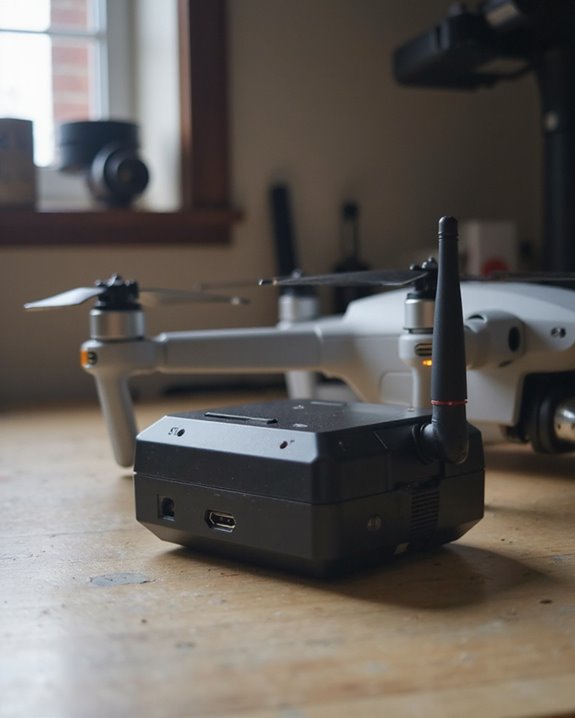
When you’re picking out the perfect Remote ID module for your drone, there’s quite a list of essential features you’ll need to check off! You’ll want to carefully evaluate everything from battery endurance and model compatibility to the module’s physical characteristics, including its GPS capabilities and how it’ll affect your drone’s performance. The way the module mounts to your aircraft is also super important – after all, you don’t want your fancy new Remote ID gadget taking an unexpected solo flight of its own!
Battery Life and Duration
The battery life of a Remote ID module can make or break your drone flying experience, especially during those long, exciting aerial sessions! You’ll be thrilled to know that today’s modules can keep you airborne for up to 5 hours on a single charge – that’s plenty of time to capture those perfect shots!
When you’re choosing your module, look for ones with fast-charging capabilities that’ll get you back in the air in just 40 minutes. Keep in mind that your actual flight time might vary depending on how intensively you’re using GPS tracking and transmission features. Don’t forget to check for those handy battery protection features – they’re like a safety net for your investment! These smart safeguards against overcharging and over-discharging will help your module’s battery stay healthy flight after flight.
Compatibility With Drone Models
Selecting a perfectly compatible Remote ID module for your drone requires careful consideration of several key factors – you’ll want to guarantee it’s a match made in the sky!
First, check your drone’s weight category, as those over 250 grams have specific regulatory requirements you can’t ignore. Whether you’re flying a nimble multirotor or a graceful fixed-wing aircraft, you’ll need a module that plays nicely with your drone’s existing communication systems. Think Bluetooth and Wi-Fi compatibility – they’re like the secret handshake between your module and drone! Size and weight are vital too, as you don’t want your module acting like an unwanted anchor. Most importantly, guarantee your chosen module works seamlessly with your drone’s GPS tracking system to broadcast flight data accurately – after all, that’s what Remote ID is all about!
Size and Weight Impact
Speaking of compatibility, size and weight specifications deserve your full attention – they’re the unsung heroes of successful Remote ID implementation! When selecting your module, you’ll want to focus on compact designs around 1.3 to 1.5 inches in length, which work wonders for reducing drag and keeping your drone steady in flight.
Look for modules weighing approximately 13.5 grams – trust me, your drone’s battery life will thank you! The best options are about 30% smaller than standard units, making installation a breeze without cramping your drone’s style. By choosing modules under 14 grams and around 0.5 inches in height, you’ll keep your aircraft nimble while staying within those pesky regulatory weight limits. After all, who doesn’t want better maneuverability and tracking accuracy without the extra bulk?
GPS Tracking Capabilities
A reliable GPS tracking system sits at the heart of any top-performing Remote ID module, and you’ll want to zero in on units offering precision better than 3 meters! Look for modules that continuously broadcast your drone’s exact coordinates, speed, and altitude – it’s like having a high-tech breadcrumb trail for your flights.
With tracking ranges reaching up to 800 meters, today’s Remote ID modules keep you connected even during those long-distance adventures. You’ll appreciate the real-time updates that help you stay compliant with regulations while maximizing your flight efficiency. The pinpoint accuracy isn’t just about following rules – it’s your ticket to safer flights and smoother operations. When every meter counts, choosing a module with robust GPS capabilities guarantees you’re always flying smart!
Installation and Mounting Options
Now that you’ve got your GPS tracking dialed in, let’s talk about making your Remote ID module a perfect fit for your drone! With these nifty devices weighing just 13-14 grams, you’ll barely notice they’re there once properly mounted.
Size matters when it comes to installation, and these compact modules (typically 1.1-1.5 inches) are designed to tuck away nicely without cramping your drone’s style. You’ve got plenty of mounting options to choose from – Velcro patches for quick switches, sturdy zip ties for extra security, or adhesive tape for that set-it-and-forget-it approach. Just remember to keep those charging ports accessible – nobody wants to play drone acrobat just to plug in their module! The best part? Installation’s a breeze with basic tools, so you’ll be up and flying in no time.
Signal Range Performance
When it comes to signal range performance, your Remote ID module needs serious broadcasting power to keep your drone visible and compliant! You’ll want to guarantee your module can maintain that vital 800-meter maximum range, which keeps you well within regulatory requirements.
Your module’s performance will vary based on real-world conditions (Mother Nature doesn’t always play nice!), typically hovering between 500 to 800 meters. The good news? Today’s modules deliver impressive GPS accuracy of less than 3 meters, so you’ll broadcast your exact coordinates with confidence. With battery life stretching up to 5 hours, you won’t have to worry about signal dropouts during extended flights.
Frequently Asked Questions
Can I Temporarily Disable My Drone’s Remote ID Module During Specific Flights?
No, you can’t legally disable your drone’s Remote ID module during flights. It’s required by FAA regulations to remain active whenever your drone is airborne – think of it like a digital license plate that must stay visible! While it might be technically possible to tamper with the module, doing so could result in hefty fines and legal trouble. Your best bet is to embrace Remote ID as a safety feature that helps keep our skies organized.
Will Remote ID Modules Affect My Drone’s Flight Performance or Battery Life?
Like adding a tiny backpack to your trusty carrier pigeon, a Remote ID module adds minimal weight and power draw to your drone. You’ll barely notice any impact on flight performance – we’re talking just a few grams here! As for battery life, most modules use very little power, typically reducing your flight time by only 1-2 minutes. The good news is that modern Remote ID technology is remarkably efficient, so you won’t have to sacrifice your drone’s capabilities.
How Often Does a Remote ID Module Need to Be Calibrated?
Good news – Remote ID modules typically don’t require regular calibration! Unlike other drone components, these modules are designed to work reliably right out of the box. You’ll only need to check the module’s settings when you first install it or if you notice any broadcast issues. Just make sure your module’s firmware stays up to date, and you’re good to go. Think of it as a “set it and forget it” kind of device!
Can Multiple Drones Use the Same Remote ID Module?
No, you can’t share a single Remote ID module between multiple drones – each drone needs its own unique module. While it might seem convenient (and cost-saving!) to swap one module between different drones, this actually defeats the whole purpose of Remote ID technology. Think of it like a digital license plate – every drone needs its own distinct identifier to maintain safety and comply with FAA regulations. Your best bet is equipping each drone with its own module.
Are Remote ID Modules Waterproof or Suitable for Flying in Rain?
Most Remote ID modules aren’t fully waterproof, so you’ll want to be cautious about flying in wet conditions. While some modules offer basic water resistance, they’re typically rated IPX4 at best – meaning they can handle light splashes but not sustained rain. You’re better off keeping your drone grounded during wet weather! If you absolutely must fly in light rain, consider using additional waterproof housing to protect your Remote ID module.





